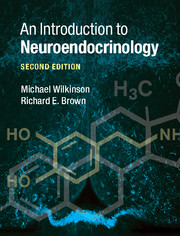Book contents
- Frontmatter
- Dedication
- Contents
- Preface to the second edition
- Acknowledgements
- List of abbreviations
- 1 Classification of chemical messengers
- 2 The endocrine glands and their hormones
- 3 The pituitary gland and its hormones
- 4 The hypothalamic hormones
- 5 Neurotransmitters
- 6 Neurotransmitter and neuropeptide control of hypothalamic, pituitary and other hormones
- 7 Regulation of hormone synthesis, storage, release, transport and deactivation
- 8 Regulation of hormone levels in the bloodstream
- 9 Steroid and thyroid hormone receptors
- 10 Receptors for peptide hormones, neuropeptides and neurotransmitters
- 11 Neuropeptides I: classification, synthesis and co-localization with classical neurotransmitters
- 12 Neuropeptides II: function
- 13 Cytokines and the interaction between the neuroendocrine and immune systems
- 14 Methods for the study of behavioral neuroendocrinology
- 15 An overview of behavioral neuroendocrinology: present, past and future
- Index
- References
10 - Receptors for peptide hormones, neuropeptides and neurotransmitters
Published online by Cambridge University Press: 05 June 2015
- Frontmatter
- Dedication
- Contents
- Preface to the second edition
- Acknowledgements
- List of abbreviations
- 1 Classification of chemical messengers
- 2 The endocrine glands and their hormones
- 3 The pituitary gland and its hormones
- 4 The hypothalamic hormones
- 5 Neurotransmitters
- 6 Neurotransmitter and neuropeptide control of hypothalamic, pituitary and other hormones
- 7 Regulation of hormone synthesis, storage, release, transport and deactivation
- 8 Regulation of hormone levels in the bloodstream
- 9 Steroid and thyroid hormone receptors
- 10 Receptors for peptide hormones, neuropeptides and neurotransmitters
- 11 Neuropeptides I: classification, synthesis and co-localization with classical neurotransmitters
- 12 Neuropeptides II: function
- 13 Cytokines and the interaction between the neuroendocrine and immune systems
- 14 Methods for the study of behavioral neuroendocrinology
- 15 An overview of behavioral neuroendocrinology: present, past and future
- Index
- References
Summary
Peptide hormones, neuropeptides, neurotransmitters and other non-steroid chemical messengers regulate cellular and biochemical activity by binding to receptors located in the plasma membranes of their target cells. These chemical messengers are generally polar and water soluble and so cannot readily enter their target cells to influence the cell nucleus in the manner described for steroid and thyroid hormones (Chapter 9). In order to induce biochemical changes within the target cell, they act as first messengers to activate a second messenger, such as cAMP, within the cytoplasm of the target cell. The transduction of information from the first to the second messenger is accomplished through the activation of membrane protein transducers (G proteins) and enzymes, such as adenylate cyclase. This chapter discusses membrane receptors for peptide hormones and neurotransmitters, the mechanisms by which signal transduction across the cell membrane occurs, the role of G proteins and receptor tyrosine kinases in this signal transduction, the second messenger systems activated, and the actions of the second messengers in the target cells, with special emphasis on neural target cells.
Some of this material was introduced in Chapter 5 and we will refer to relevant figures where appropriate.
Membrane receptors
Membrane receptors are complex proteins embedded in the cell membrane. The function of these receptors is to recognize specific ligands in the blood (e.g. peptide hormones, neuropeptides) or in the synapse (e.g. neurotransmitters) and bind to them. Once this binding occurs, signal transduction across the cell membrane occurs as described in section 10.2 below. As noted in the description of steroid hormone receptors, modern techniques of immunohistochemistry (using antibodies to receptor proteins) and in situ hybridization (allowing visualization of peptide mRNA) permit the ready localization of membrane receptors in any tissue of interest. Gene cloning and sequencing techniques enabled molecular biologists to develop three-dimensional models of many membrane receptors. There are three distinct types of membrane receptor: (1) ligand-gated ion channel receptors; (2) guanine nucleotide binding protein (G-protein-) coupled receptors; and (3) transmembrane-regulated tyrosine kinases.
- Type
- Chapter
- Information
- An Introduction to Neuroendocrinology , pp. 236 - 256Publisher: Cambridge University PressPrint publication year: 2015



